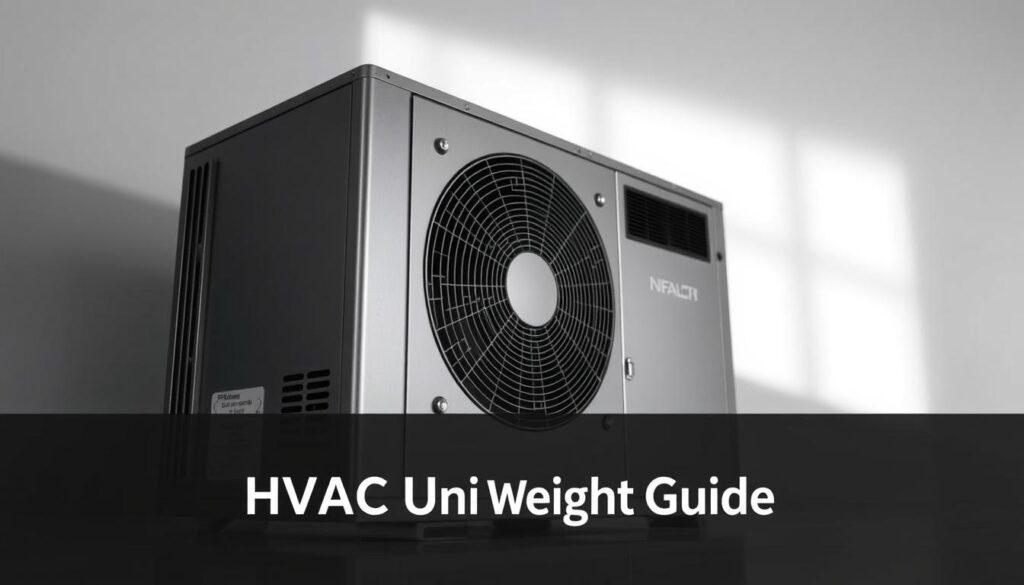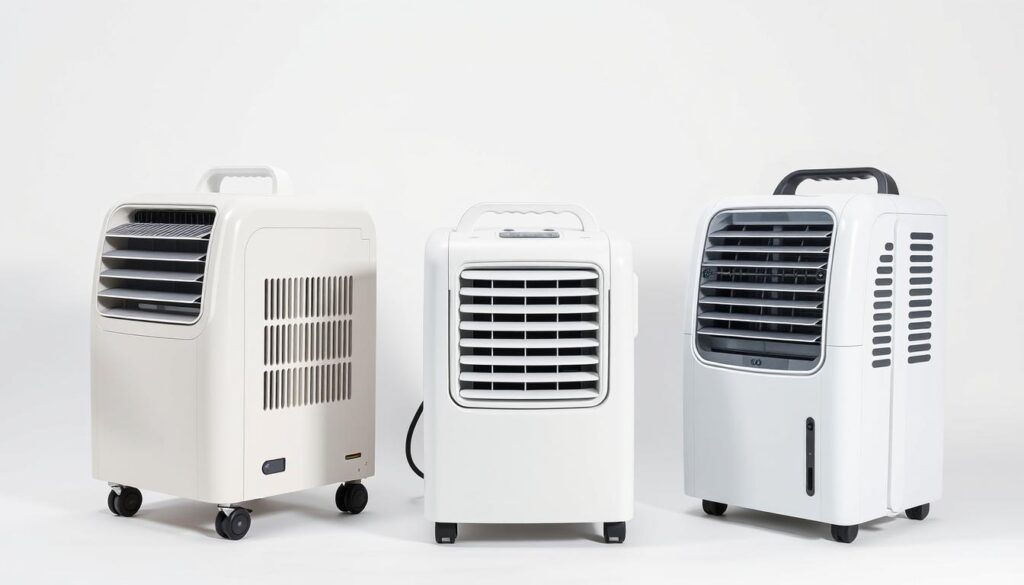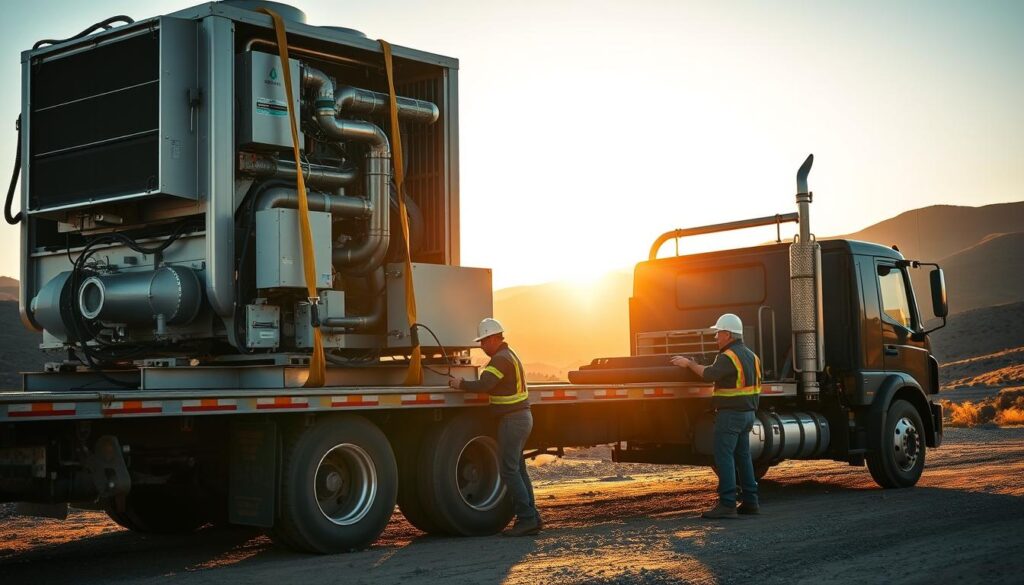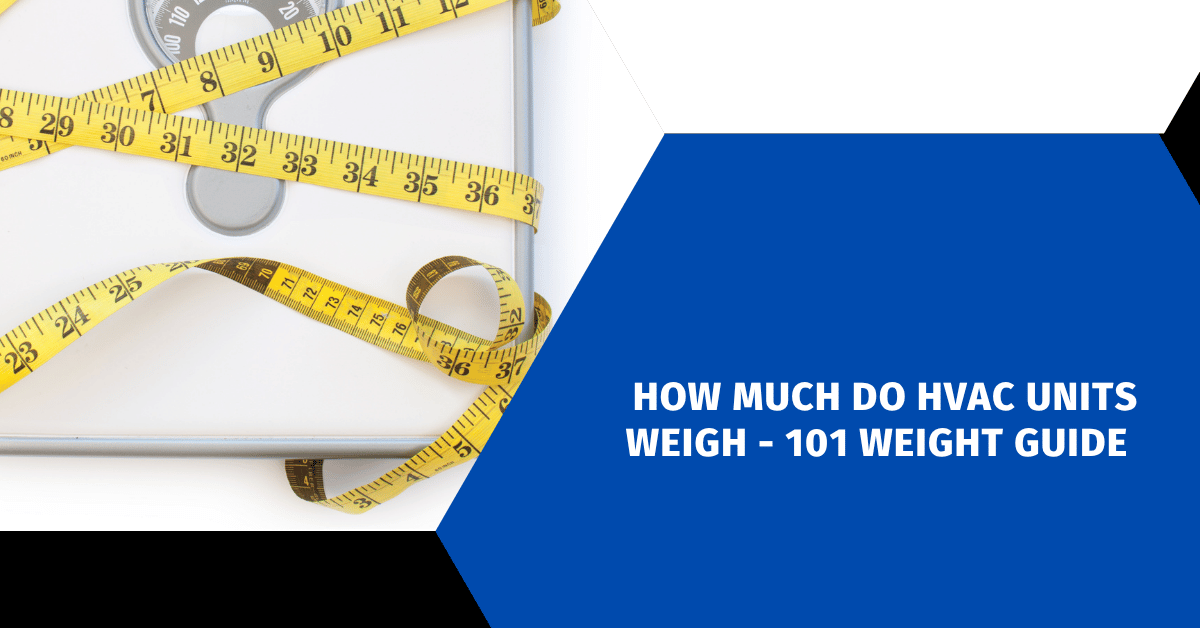Affiliate Disclosure
HVAC Guide Guys is a participant in the Amazon Services LLC Associates Program, an affiliate advertising program designed to provide a means for sites to earn advertising fees by advertising and linking to Amazon.
How Much Do HVAC Units Weigh? Ever thought about how much an HVAC unit weighs? It’s more important than you might think. The weight of an HVAC unit affects everything from moving it to how well your building stands.

In 2024, HVAC tech keeps getting better. This means new systems with their own weight challenges. Knowing your HVAC’s weight can save you time, money, and avoid building problems.
This guide will cover everything about HVAC unit weights. We’ll look at how different systems, sizes, and uses affect weight. From small home units to big commercial ones, we’ll explain the key weight factors for everyone.
Key Takeaways
- HVAC unit weights vary significantly based on system type and capacity
- Understanding weight is key for proper installation and building planning
- Modern HVAC systems have different weight profiles than older ones
- Transportation and mounting needs depend on the unit’s weight
- Getting a pro’s help is wise for complex HVAC jobs
Table of Contents
Understanding HVAC Unit Weight Classifications
When looking at HVAC systems, knowing the weight classes is key for both homeowners and pros. The weight of an HVAC system changes a lot between different types. This affects everything from how easy it is to install to how well it works.
Every air conditioning unit’s weight is important for choosing the right one. Let’s explore what makes an HVAC unit’s weight and how it’s classified.
Residential vs Commercial Units
HVAC units are very different for homes and businesses. Home systems are usually lighter and smaller. But, business units need to be stronger and bigger.
- Residential units: 100-500 pounds
- Commercial units: 500-2,000 pounds
- Industrial-grade systems: 2,000-5,000 pounds
Weight Impact on Installation
The weight of an HVAC system affects how hard it is to install. Heavier units need:
- Specialized lifting equipment
- Reinforced mounting structures
- More support for the structure
Material Components and Their Weight Contribution
| Component | Average Weight Contribution |
|---|---|
| Compressor | 30-40% of total unit weight |
| Condenser Coils | 15-25% of total unit weight |
| Electrical Components | 10-15% of total unit weight |
| Structural Frame | 20-30% of total unit weight |
Knowing about these weight classes helps you pick the best HVAC system. It ensures it works well and is easy to install.
How Much Do HVAC Units Weigh: A Complete Guide
Knowing how much HVAC units weigh is key for homeowners and pros. It’s important for planning installations or replacements. The weight of heating and cooling units changes based on several factors.
HVAC units vary in weight, depending on their design and purpose. Home systems are different from commercial ones. Let’s look at the main weight factors:
- Residential central air conditioning units usually weigh between 150-250 pounds
- Commercial HVAC systems can range from 500-2,000 pounds
- Rooftop units often weigh 500-1,500 pounds depending on capacity
The weight of HVAC components depends on several things:
- Compressor material and design
- Cooling capacity (measured in tons)
- Structural materials used in construction
- Specific technological features
| HVAC Unit Type | Average Weight Range | Typical Application |
|---|---|---|
| Window AC Unit | 50-100 lbs | Small Spaces |
| Split System | 150-250 lbs | Residential Homes |
| Commercial Package Unit | 500-1,500 lbs | Large Buildings |
Remember, weight affects installation, transport, and support needs. Always get a pro’s opinion for the right system.
Explore Our HVAC Shop
Looking for top-rated HVAC tools, parts, and accessories? Visit our shop and find the perfect solution for your needs.
Visit the ShopWeight Variations Based on Cooling Capacity
It’s important to know how an HVAC unit’s cooling power affects its weight. The weight of your HVAC unit is linked to its performance, like BTU ratings and tonnage.
HVAC systems vary in size and weight. Several factors, like components, affect their mass. The weight of your furnace also depends on these factors, impacting its cooling efficiency.
BTU Ratings and Unit Weight
BTU ratings are key in determining an HVAC unit’s weight. Higher BTU ratings mean:
- More cooling power
- Stronger internal parts
- Heavier overall unit
Tonnage Impact on Unit Mass
HVAC tonnage affects the unit’s weight. One ton of cooling equals 12,000 BTUs per hour. As tonnage goes up, so does the weight:
- 1-ton units: Lightest, 100-200 pounds
- 2-ton units: Moderate, 200-300 pounds
- 3-ton units: Heavier, 300-400 pounds
- 5-ton units: Heaviest for homes, 400-500 pounds
Size-to-Weight Ratio Guidelines
When picking an HVAC system, think about the size-to-weight ratio. Bigger units with more cooling power are heavier because of:
- More metal parts
- Complex heat exchange systems
- Advanced cooling tech
Your HVAC unit’s weight depends on its design, materials, and cooling needs. Getting a professional’s opinion helps pick the right unit for your space.
Standard Weight Ranges for Residential HVAC Systems
Knowing the weight of your HVAC system is key when planning installations or replacements. Modern air conditioning units vary a lot in weight. They can weigh from 100 to 500 pounds, with most central air units between 150 and 300 pounds.
The weight of an air conditioning unit depends on several factors:
- Compressor size and type
- Cooling capacity (measured in tons)
- Energy efficiency ratings
- Material composition
When looking at air conditioning unit weight, different types have their own weights:
- Split-system central air conditioners: 150-250 pounds
- Heat pumps: 200-300 pounds
- Packaged HVAC units: 300-500 pounds
Newer HVAC systems are lighter without losing performance. They use materials like aluminum and advanced composites. This makes them easier to install and may reduce the load on your home.
Your HVAC system’s weight depends on your home’s size, local climate, and cooling needs. A professional HVAC contractor can give you the right measurements and advice for your home.
Explore Our HVAC Shop
Looking for top-rated HVAC tools, parts, and accessories? Visit our shop and find the perfect solution for your needs.
Visit the ShopCommercial HVAC Unit Weight Specifications
Commercial HVAC systems are engineering wonders. The weight of these systems is key in design and installation. They are much bigger than home systems, needing special attention to weight, performance, and how they fit into buildings.
Looking into commercial HVAC weight, you find many factors that make them heavy. These systems are big and complex. They need careful thought about how their weight is spread out and how they fit into buildings.
Large-Scale System Weights
Commercial HVAC units vary a lot in weight. Here are some typical weight ranges:
- Small commercial units: 500-2,000 pounds
- Medium-sized systems: 2,000-5,000 pounds
- Large industrial systems: 5,000-15,000 pounds
Industrial Grade Equipment Considerations
Industrial-grade HVAC equipment is built tough for harsh environments. Their weight shows their strength and ability to handle big cooling and heating needs.
Multi-Zone System Weight Factors
Multi-zone commercial systems add more to weight calculations. Key factors include:
- Number of connected zones
- Ductwork complexity
- Advanced control systems
- Material composition
Knowing these weight details helps experts make better choices for HVAC installations. This ensures buildings are strong and systems work well.
Portable and Window AC Unit Weight Guide
Knowing the weight of portable and window AC units is key when choosing a cooling solution. The weight of portable AC units changes based on their cooling power and design. Most people find these units weigh between 30 to 80 pounds, which is easy to handle for home setup.

For window AC units, several factors affect their weight. Smaller units for tight spaces weigh 40 to 60 pounds. Larger units for bigger rooms can be up to 100 pounds.
- Compact units (5,000-8,000 BTU): 30-50 pounds
- Medium-sized units (8,000-12,000 BTU): 50-70 pounds
- Large units (12,000-15,000 BTU): 70-100 pounds
New technology has made air conditioning units lighter. Lightweight materials and compact designs make them easier to move and install than older models.
| AC Unit Type | Average Weight Range | Typical BTU Capacity |
|---|---|---|
| Portable AC | 30-80 lbs | 8,000-14,000 BTU |
| Window AC | 40-100 lbs | 5,000-15,000 BTU |
Always check the weight needs for your space before buying. Think about the strength of mounting surfaces, window frame support, and your ability to safely lift and place the unit. Choosing the right portable AC unit weight ensures it works well and is easy to install.
Weight Considerations for Rooftop HVAC Installations
Rooftop HVAC installations come with their own set of challenges. The weight of the HVAC unit is key to figuring out if it’s safe to put it on top of buildings. This is true for both commercial and industrial structures.
When you’re planning to put an HVAC unit on a roof, you have to think about a few important things. The weight of the commercial HVAC system affects how much weight the building can hold. It also changes how the building is designed.
Structural Requirements for Rooftop Installations
Before you can put an HVAC unit on a roof, you need to look at a few important things:
- Roof material and condition
- Building age and original design specs
- Existing structural support systems
- Local building codes and regulations
Load-Bearing Calculations
Engineers use detailed math to check if a roof can handle an HVAC unit’s weight. They look at:
- The total weight of the HVAC unit
- The roof’s current strength
- If more support is needed
- How the weight is spread out
Pro tip: Always talk to a structural engineer before putting a rooftop HVAC system in. This helps avoid damage and keeps everyone safe.
Proper weight distribution is key to keeping your building’s roof strong over time.
Explore Our HVAC Shop
Looking for top-rated HVAC tools, parts, and accessories? Visit our shop and find the perfect solution for your needs.
Visit the ShopTransport and Installation Weight Requirements

Moving an HVAC system needs careful planning and knowing its weight. The weight of the HVAC system is key for moving and installing it. Each unit has its own needs for safe and efficient transport and setup.
When thinking about how much HVAC units weigh, you face several big challenges:
- Choosing the right vehicles for transport
- Having the right lifting tools
- Keeping the unit safe during travel
- Knowing what the installation team needs
Experts use special trucks and trailers for moving heavy HVAC units. The unit’s weight decides how many workers are needed for safe setup. Small units might need two people, but big commercial ones could need teams of four or more.
Important things to think about for moving include:
- How to distribute the unit’s weight
- Securing it to avoid damage
- Picking vehicles that can handle the weight
- Planning a safe route to the installation site
Your installation team must check the structure, if any extra support is needed, and how to place it exactly. Knowing the HVAC system’s weight helps avoid damage and ensures it works well for a long time.
Professional tip: Always check the unit’s weight before moving and installing it to ensure safety and efficiency.
Energy Efficiency Impact on Unit Weight
The weight of heating and cooling units is now key in HVAC design. Companies aim to make lightweight systems that work well and use less energy.
New HVAC tech is changing how we see air conditioning unit weight. Engineers are making systems that are lighter and more efficient than old ones.
Modern Materials Transforming Weight Reduction
New materials are improving HVAC design a lot. They let makers create systems that are both light and efficient:
- Advanced aluminum alloys
- Composite polymer structures
- Lightweight carbon fiber elements
- Precision-engineered plastics
Performance versus Weight Trade-offs
Your HVAC system can be efficient without losing performance. Makers are finding ways to balance both:
- Compact design strategies
- Enhanced thermal conductivity materials
- Precision engineering techniques
By making units lighter, companies can make systems that save you money. This is true for both the cost of installation and running costs over time.
Explore Our HVAC Shop
Looking for top-rated HVAC tools, parts, and accessories? Visit our shop and find the perfect solution for your needs.
Visit the ShopImportant Factors Affecting HVAC Unit Weight
Knowing what affects hvac unit weight is key to choosing the right heating and cooling systems. Modern HVAC systems have many parts that add to their weight and how well they work.
Several important factors affect the weight of an HVAC unit and furnace:
- Material composition of core components
- Technological design features
- Energy efficiency requirements
- Cooling and heating capacity specifications
Compressors are a big deal when it comes to hvac unit weight. Advanced compressor technologies like variable-speed motors help make systems lighter while saving energy. Heat exchangers, made from materials like aluminum or copper, also add a lot to the unit’s weight.
Today’s environmental rules have led to lighter, more compact HVAC systems. New materials and designs let engineers make furnaces and cooling units that are lighter but just as good.
Technological advancements continue to transform HVAC equipment design, making units more lightweight and energy-efficient.
Energy efficiency standards really shape hvac unit weight. Companies have to find ways to meet performance needs without making systems too heavy. This leads to clever engineering that balances weight and function.
Conclusion
Exploring how much HVAC units weigh shows us their weight is key. It affects everything from choosing the right system to how well it works. This is true for homes and big commercial buildings alike.
Knowing about weight helps you pick the right cooling solution. Things like how much it cools, what it’s made of, and new tech all play a part. Today’s HVAC makers are working on systems that are lighter but just as good.
Knowing about HVAC weights helps you plan better. Whether it’s for a small home or a big business, knowing the weight is important. It helps with setup, moving, and keeping the system running well for years.
The future of HVAC looks bright. New materials and designs will change how we think about cooling system weights. This will make systems better for homes and businesses.

